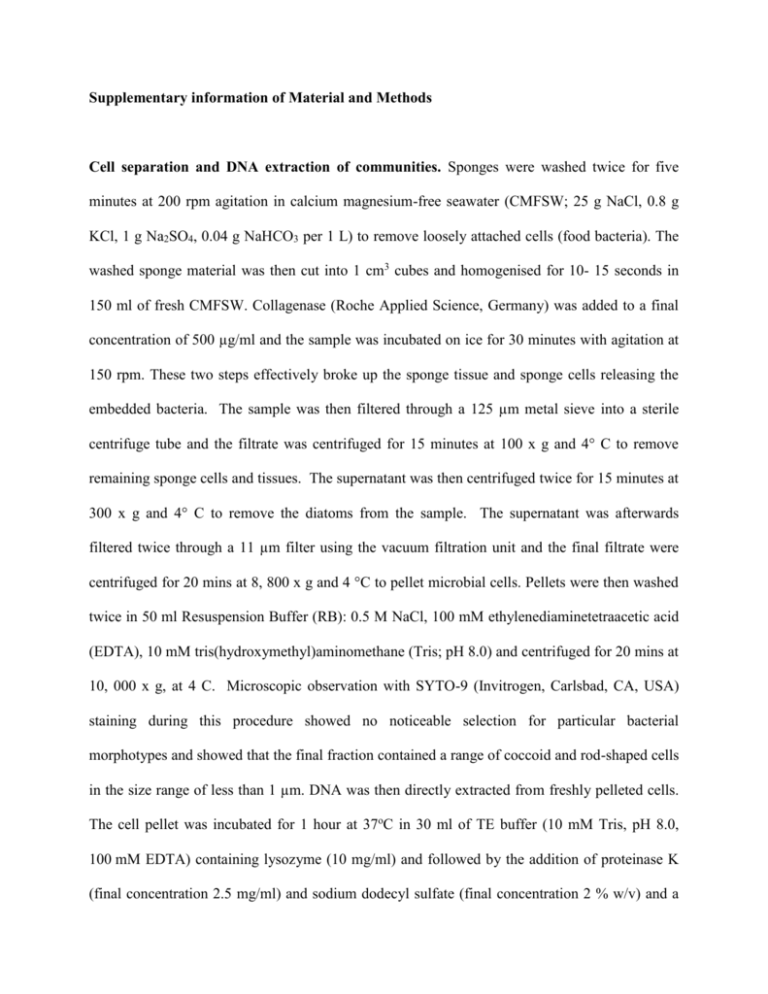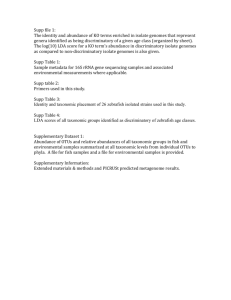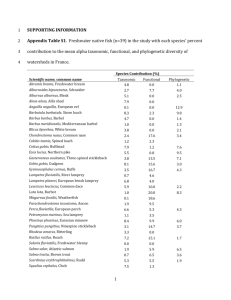Sampling, cell separation and DNA extraction of communities
advertisement

Supplementary information of Material and Methods Cell separation and DNA extraction of communities. Sponges were washed twice for five minutes at 200 rpm agitation in calcium magnesium-free seawater (CMFSW; 25 g NaCl, 0.8 g KCl, 1 g Na2SO4, 0.04 g NaHCO3 per 1 L) to remove loosely attached cells (food bacteria). The washed sponge material was then cut into 1 cm3 cubes and homogenised for 10- 15 seconds in 150 ml of fresh CMFSW. Collagenase (Roche Applied Science, Germany) was added to a final concentration of 500 µg/ml and the sample was incubated on ice for 30 minutes with agitation at 150 rpm. These two steps effectively broke up the sponge tissue and sponge cells releasing the embedded bacteria. The sample was then filtered through a 125 µm metal sieve into a sterile centrifuge tube and the filtrate was centrifuged for 15 minutes at 100 x g and 4° C to remove remaining sponge cells and tissues. The supernatant was then centrifuged twice for 15 minutes at 300 x g and 4° C to remove the diatoms from the sample. The supernatant was afterwards filtered twice through a 11 µm filter using the vacuum filtration unit and the final filtrate were centrifuged for 20 mins at 8, 800 x g and 4 °C to pellet microbial cells. Pellets were then washed twice in 50 ml Resuspension Buffer (RB): 0.5 M NaCl, 100 mM ethylenediaminetetraacetic acid (EDTA), 10 mM tris(hydroxymethyl)aminomethane (Tris; pH 8.0) and centrifuged for 20 mins at 10, 000 x g, at 4 C. Microscopic observation with SYTO-9 (Invitrogen, Carlsbad, CA, USA) staining during this procedure showed no noticeable selection for particular bacterial morphotypes and showed that the final fraction contained a range of coccoid and rod-shaped cells in the size range of less than 1 µm. DNA was then directly extracted from freshly pelleted cells. The cell pellet was incubated for 1 hour at 37oC in 30 ml of TE buffer (10 mM Tris, pH 8.0, 100 mM EDTA) containing lysozyme (10 mg/ml) and followed by the addition of proteinase K (final concentration 2.5 mg/ml) and sodium dodecyl sulfate (final concentration 2 % w/v) and a further incubation at 50oC for 2 hours. Microscopy showed effective lysis of all cell types by this process. The lysed cells were then extracted twice using 1 volume of phenol:chloroform:isoamyl alcohol (25:24:1; Fluka, Germany) and centrifuged at 2000 x g for 10 minutes. The aqueous phase was recovered and one volume of ice-cold isopropanol was added followed by incubation at -20oC for 16 hours. The DNA was pelleted at 20, 000 x g for 30 minutes at 4oC, then air-dried, resuspended in TE buffer with RNaseA (10 µg / ml) and incubated at 37oC for 1 hour. The DNA was further purified by extraction with 1 volume of phenol:chloroform:isoamyl alcohol mix and precipitated from the aqueous phase with 0.1 volume of 3M sodium acetate and 2.5 volume of ethanol. The DNA was pelleted at 20, 000 x g for 30 minutes at 4oC, washed with 70 % ethanol, air-dried and resuspended in TE buffer. The quality and quantity of DNA were checked using agarose gel electrophoresis. Binning: Tetranucleotide patterns were determined using TETRA (Teeling et al 2004) and exported as normalised Zscores. Clustering was performed with Euclidian distance and complete linkage using the software Cluster 3.0 and visualised with JavaTreeView (Eisen et al 1998). A handcurated sub-set of scaffolds was identified to link phylogenetic information to the distinct tetranucleotide clusters. Hand-curation defined a scaffold to a particular phylogenetic origin when either a) a 16S rRNA gene (>1200 bp) was present with greater 99% identify to the 16S rRNA clusters defined in the phylogenetic analysis (Fig. 1) or b) a marker gene was present that could be unambiguously assigned to an appropriate taxonomic level matching the phylogenetic analysis and c) the scaffold showed no evidence of mis-assembly. Hand-curated scaffolds were obtained for the sponge’s Bdellovibrionales, Phyllobacteriaceae, Sphingomondales, Piscirickettsiaceae and gammaproteobacteria 1 group. These scaffolds were used to define the border and depth of clusters in the hierarchical tree (Fig. S1). These clusters were subsequently checked for robustness using k-means clustering (Euclidian distance with Cluster 3.0) with the number of seeds set at 14 (corresponding to the number of major clusters identified in the phylogenetic analysis). The hand-curated scaffolds were again confined to distinct k-means clusters implying that alternative clustering to the one used in the hierarchical tree is unlikely. The hand-curated clusters were subsequently expanded to include all scaffolds contained in their corresponding sub-tree. In the next step these expanded bins were used to define new clusters in a tree generated as described above, but with scaffolds with more than 5Kb sequence. For the Phyllobacteriaceae and Sphingomondales several branches overlapped between the previously distinct clusters indicating that the shorter sequences can not be unambiguously defined to either of the two bins. For the other three organisms several smaller scaffolds could be added to their respective bin as the 20Kb scaffolds defined distinct and deep branching sub-trees. The five organismal bins were further validated as follows. Firstly, each scaffold was compared to all proteins in NR and best matching positions were assigned to the taxon associated with the protein. The most abundant taxon at any level (species to kingdom) was then used as a taxonomic assignment of the scaffolds at a particular level. This homology-based taxon assignment showed in no case a conflict with the composition-based taxonomic assignment of the cluster it belongs to. Secondly, each of the five bins had only one representative from a set of 31 conserved, singlecopy marker proteins (Ciccarelli et al 2006) indicating that no “hybrid” or “chimeric” genome bins were created. References: Ciccarelli FD, Doerks T, von Mering C, Creevey CJ, Snel B, Bork P (2006). Toward automatic reconstruction of a highly resolved tree of life. Science 311: 1283-1287. Eisen MB, Spellman PT, Brown PO, Botstein D (1998). Cluster analysis and display of genomewide expression patterns. Proc Natl Acad Sci U S A 95: 14863-14868. Teeling H, Meyerdierks A, Bauer M, Amann R, Glockner FO (2004). Application of tetranucleotide frequencies for the assignment of genomic fragments. Environ Microbiol 6: 938947. Legends for supplementary figures and tables Fig. S1. Tetra-nucleotide-based clustering of scaffolds with more than 20Kb sequence and genomic features for the sponge-bacteria derived metagenome. The left tree shows the clustering of the scaffolds, while the top indicates the tetra-nucleotide trees. The heat map shows over- and under-represented tetra-nucleotides in green and red, respectively. Scaffold clusters that could be unambiguously linked to phylogenetic groups are boxed in blue with the corresponding taxonomic assignment to the right. The table on the right shows the genomic features of those partial bacterial genomes associated with C. concentrica. Abbreviations: nd: not detected, BV=Bdellovibrionales; PB= Phyllobacteriaceae; SM= Sphingomondales; PR= Piscirickettsiaceae; G1= gamma-proteobacteria 1. Fig. S2. Abundance of insertion sequence elements in the plankton and sponge metagenome. The top 34 most abundant element sequences are shown for each dataset. Abundance is normalised to genome equivalent number in each dataset and the average is shown for the two replicates of each dataset. Fig. S3. Abundance of CRISPR elements of various lengths in planktonic and sponge-associated bacterial communities. Error bars indicate calculated standard variations of replicates. The pvalues shown in the figure are based on a t-test analysis. Fig. S4. Neighbor joining tree of the medium-size subunit of the aerobic-type carbon monoxide dehydrogenase (CoxM) (left tree) and sponge bacterial ankyrin repeat proteins and related ankyrin repeat sequences (right tree). Numbers refer to unique IDs in the metagenome dataset of this study. Bootstraps values are only shown for less than 500 observations in 1000 replicates. The protein sequence of the medium-size subunit of nicotine dehydrogenase from Arthrobacter nicotinovorans was added as an outgroup. Representative sequences for form I and putative form II carbon monoxide dehydrogenase are also shown. Naming of sequences refers to sample (BBAY01 and 02 correspond to planktonic samples and BBAY04 and 15 correspond to sponge samples) followed by an unique protein identifier. Only bootstrap value < 500 are shown for 1000 replicates. Fig. S5. Abundance of repeat numbers for ankyrin (ANK) and TPR (SEL1, named according to PFAM) motifs in the sponge metagenome. Table Legends: Table S1: Basic sequencing, assembly, annotation statistics and taxonomic assignment of ORF in the sponge-associated (BBAY04 and BBAY15) and plankonic (BBAY01 and BBAY02) metagenome. Counts per assignment level are shown in absolute number. Numbers in brackets are fractional contribution expressed as the percentage of the total ORFs that could be assigned. Table S2. Abundance of COGs and TIGRFAMs with association to CAS proteins in planktonic (BBAY01 and 02) and sponge-associated (BBAY04 and 15) bacterial metagenomes. Abundance of samples has been normalised for genome equivalent contained in each dataset. S/P indicates average abundance of sponge metagenome divided by average abundance of the plankton metagenome. Only COGs with S/P values of greater than 3 and smaller than 0.3 and t-test p values < 0.05 are shown. Data in table is sorted in descending order of the S/P ratio. Table S3. Nutrient analysis of water in Botany Bay Table S4. Taxonomic assignments of ankyrin repeat proteins. Lowest taxonomic assignment is shown








